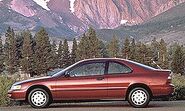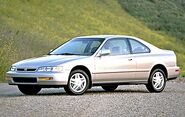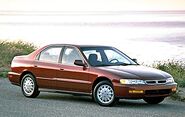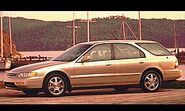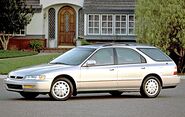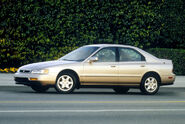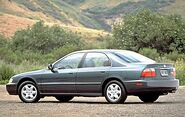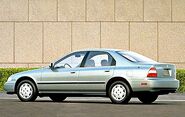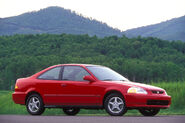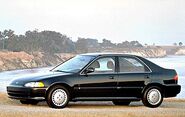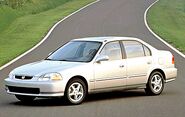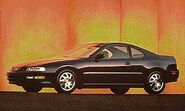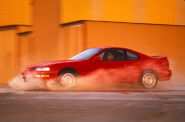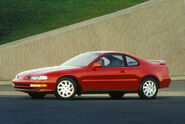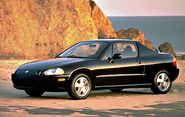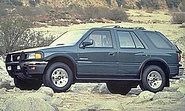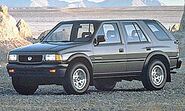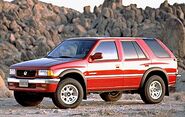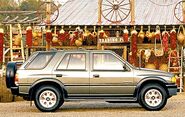No edit summary |
|||
| Line 29: | Line 29: | ||
===1991=== |
===1991=== |
||
During the Honda Civic's fourth generation, the car was sold as a 2-door hatchback, 4-door sedan, and a 4-door station wagon. The hatchback consisted of base, CRX, CRX Si, DX, and Si models, while the sedan consisted of DX, EX and LX models, and the wagon only had one model. |
During the Honda Civic's fourth generation, the car was sold as a 2-door hatchback, 4-door sedan, and a 4-door station wagon. The hatchback consisted of base, CRX, CRX Si, DX, and Si models, while the sedan consisted of DX, EX and LX models, and the wagon only had one model. |
||
| + | ===1995=== |
||
| − | + | For 1995, front-wheel-drive Civics are still economical, well-built and great fun, but they've proliferated to three body styles, six trim levels and four separate engines. There are even seven colors. The Civic's competitors have proliferated to include the Toyota Tercel and Corolla, Geo Prizm, Mitsubishi Mirage, Saturn SC1, Dodge/Plymouth Neon and Nissan Sentra. |
|
The chopped-off little Civic Hatchback comes as a price-leader CX, a super-economical, 56-mpg VX, a midlevel DX and a sporty Si. The notchback Coupe is a foot longer and comes in DX and fancy EX trim. The 4-door Civic Sedan can be had as a DX, LX or luxurious EX. All three body styles are available with 4-wheel ABS disc brakes, 5-speed manual or 4-speed automatic transaxles. |
The chopped-off little Civic Hatchback comes as a price-leader CX, a super-economical, 56-mpg VX, a midlevel DX and a sporty Si. The notchback Coupe is a foot longer and comes in DX and fancy EX trim. The 4-door Civic Sedan can be had as a DX, LX or luxurious EX. All three body styles are available with 4-wheel ABS disc brakes, 5-speed manual or 4-speed automatic transaxles. |
||
Honda offers four variations of the same basic 4-cylinder engine, ranging from 70 hp to 125 hp. The most powerful 1.6-liter version features VTEC variable valve timing just like the most expensive sports cars. The hottest combination is the lightweight 125-hp Si with 5-speed, disc/disc brakes and ABS. |
Honda offers four variations of the same basic 4-cylinder engine, ranging from 70 hp to 125 hp. The most powerful 1.6-liter version features VTEC variable valve timing just like the most expensive sports cars. The hottest combination is the lightweight 125-hp Si with 5-speed, disc/disc brakes and ABS. |
||
The same drivetrain in the EX 4-door produces a surprisingly sophisticated family sedan with good performance and such standard equipment as a power moonroof, air conditioning and fancy AM/FM sound system with built-in antitheft device. |
The same drivetrain in the EX 4-door produces a surprisingly sophisticated family sedan with good performance and such standard equipment as a power moonroof, air conditioning and fancy AM/FM sound system with built-in antitheft device. |
||
| + | ===1996=== |
||
| + | The 1996 Civic was introduced late in August 1995, and went on sale in mid-October 1995. |
||
<gallery> |
<gallery> |
||
| Line 65: | Line 68: | ||
Like the Civic upon which it is based, the Del Sol comes in 102-hp S and 125-hp Si models. But unlike the Civic, there is also a 160-hp version of the 1.6-liter engine, this one fitted with dohc and Honda's variable valve timing and lift system called VTEC. As you might expect, the VTEC Del Sol is a blast to drive. It has more than enough horsepower, larger disc brakes, stiffer suspension and V-rated tires. Surprisingly, the Civic's ABS system is not available on Del Sol. |
Like the Civic upon which it is based, the Del Sol comes in 102-hp S and 125-hp Si models. But unlike the Civic, there is also a 160-hp version of the 1.6-liter engine, this one fitted with dohc and Honda's variable valve timing and lift system called VTEC. As you might expect, the VTEC Del Sol is a blast to drive. It has more than enough horsepower, larger disc brakes, stiffer suspension and V-rated tires. Surprisingly, the Civic's ABS system is not available on Del Sol. |
||
Honda's Del Sol is one of the most practical small sports cars ever designed. The hardtop roof makes it more theftproof than a convertible, the surprisingly large trunk plus storage space behind the seats make it capable of carrying a week's worth of groceries or luggage, front-wheel drive means it goes in snow. |
Honda's Del Sol is one of the most practical small sports cars ever designed. The hardtop roof makes it more theftproof than a convertible, the surprisingly large trunk plus storage space behind the seats make it capable of carrying a week's worth of groceries or luggage, front-wheel drive means it goes in snow. |
||
| + | ===1996=== |
||
| + | The 1996 Del Sol went on sale in early 1996. |
||
<gallery> |
<gallery> |
||
| Line 79: | Line 84: | ||
For 1995, the Passport is a carryover model, receiving only a few minor interior and exterior changes. A variety of engine and transmission options with either 2-wheel-drive or 4-wheel drive are available. The base DX model has 2wd, a 5-speed manual transmission and an sohc 2.6-liter inline 4-cylinder engine. |
For 1995, the Passport is a carryover model, receiving only a few minor interior and exterior changes. A variety of engine and transmission options with either 2-wheel-drive or 4-wheel drive are available. The base DX model has 2wd, a 5-speed manual transmission and an sohc 2.6-liter inline 4-cylinder engine. |
||
Midlevel LX and upscale EX models feature a sohc 3.2-liter V6 and a choice of a 5-speed manual or 4-speed automatic transmission. The automatic has a "winter start" mode that holds the transmission in Third gear to help get it rolling on slippery surfaces. The LX is available with 2wd or 4wd, but all EXs are 4x4s. Power steering, rear ABS, tinted glass and exterior spare tire are standard on all Passports. |
Midlevel LX and upscale EX models feature a sohc 3.2-liter V6 and a choice of a 5-speed manual or 4-speed automatic transmission. The automatic has a "winter start" mode that holds the transmission in Third gear to help get it rolling on slippery surfaces. The LX is available with 2wd or 4wd, but all EXs are 4x4s. Power steering, rear ABS, tinted glass and exterior spare tire are standard on all Passports. |
||
| + | ===1996=== |
||
| + | The 1996 Honda Passport went on sale in early 1996. |
||
<gallery> |
<gallery> |
||
Revision as of 20:37, 28 July 2014
Honda Accord
1991
The Honda Accord has been neck and neck with the Ford Taurus for "best-selling model in America" for years. In its fourth generation, the Accord was available as a notchback coupe, 4-door sedan or 5-door station wagon. The coupe was available in three trim and equipment levels, base DX, midlevel LX and high-line EX, while the sedan also included a Special Edition. The wagon came only with LX or EX trim.
1995
The midsize, front-drive Accord competes with the Ford Taurus, Toyota Camry, Nissan Altima, Mitsubishi Galant, Mazda 626, any number of front-drive GM sedans and the new Cirrus/Stratus from Chrysler and Contour/Mystique from Ford. It got new bodywork last year and a long-awaited V6 engine option for 1995. Compared to former Accords, the current cars are larger, smoother, quieter and more luxurious. The 2.2-liter 4-cylinder engine is available in 130-hp or 145-hp VTEC tune with either a 5-speed manual or 4-speed automatic transmission. The new 24-valve 2.7-liter 170-hp V6 was developed from the old Acura Legend V6 (the current Legend's 3.2-liter V6 is a completely different engine). To accommodate this bigger, more powerful engine, the hood on V6 models is slightly higher and the car about 2 in. longer than 4-cylinders. The V6 is available only on LX and EX sedans, with automatic transmission and 4-wheel-disc ABS standard. Brakes on the base models are disc/drum, but the all-disc ABS is optional. Unlike many more expensive cars that still use MacPherson strut suspension, the Accord has racing-style independent upper and lower A-arms front and rear. These give more consistent handling and a better ride.
Honda Civic
In 1979, there were two Honda Civics, a hatchback and a sedan, available in three colors with almost no options. These Civics redefined the concept of economy cars, being not only economical but durable and a blast to drive.
1991
During the Honda Civic's fourth generation, the car was sold as a 2-door hatchback, 4-door sedan, and a 4-door station wagon. The hatchback consisted of base, CRX, CRX Si, DX, and Si models, while the sedan consisted of DX, EX and LX models, and the wagon only had one model.
1995
For 1995, front-wheel-drive Civics are still economical, well-built and great fun, but they've proliferated to three body styles, six trim levels and four separate engines. There are even seven colors. The Civic's competitors have proliferated to include the Toyota Tercel and Corolla, Geo Prizm, Mitsubishi Mirage, Saturn SC1, Dodge/Plymouth Neon and Nissan Sentra. The chopped-off little Civic Hatchback comes as a price-leader CX, a super-economical, 56-mpg VX, a midlevel DX and a sporty Si. The notchback Coupe is a foot longer and comes in DX and fancy EX trim. The 4-door Civic Sedan can be had as a DX, LX or luxurious EX. All three body styles are available with 4-wheel ABS disc brakes, 5-speed manual or 4-speed automatic transaxles. Honda offers four variations of the same basic 4-cylinder engine, ranging from 70 hp to 125 hp. The most powerful 1.6-liter version features VTEC variable valve timing just like the most expensive sports cars. The hottest combination is the lightweight 125-hp Si with 5-speed, disc/disc brakes and ABS. The same drivetrain in the EX 4-door produces a surprisingly sophisticated family sedan with good performance and such standard equipment as a power moonroof, air conditioning and fancy AM/FM sound system with built-in antitheft device.
1996
The 1996 Civic was introduced late in August 1995, and went on sale in mid-October 1995.
Honda Prelude
1991
Before the 1990s, the Honda Prelude was still in its third generation, and up to the 1991 model year, it had three trims: Si, Si 2.0 and Si 4WS.
1992
The sleek Prelude coupe was derived from Honda's Accord sedan. Six inches have been chopped out of the Accord's wheelbase, but its racing style upper and lower A-arm suspension, front-wheel-drive transaxle and 2.2-liter 4-cylinder engine remain. Base engine is the same sohc powerplant used in the Accord, slightly upgraded to 135 hp. The sportier Si and unusual 4-wheel-steer 4WS are fitted with a 160-hp 2.3-liter version with a dohc cylinder head. The top-line VTEC adds Honda's patented variable valve-timing and lift electronic control to extract 190 hp from a 2.2-liter dohc engine. The Prelude is in a tough market, competing against the Ford Probe, Mazda MX-6, Nissan 240SX, Toyota Celica and, at a comparable price, the larger, faster Chevrolet Camaro and Ford Mustang. The Prelude succeeds by a combination of beautiful styling, exquisite road manners, good power, a comfortable cockpit and Honda's famous quality. In addition, the Prelude offers options, like the electronically controlled rear-wheel steering on the 4WS, which aren't available on other cars of this type. Like all Hondas, the Prelude is fitted with a wide range of features as standard equipment. The midlevel Si has the power windows, cruise control and adjustable steering column of the base S model, but adds a/c, power locks, a fancy sound system, alloy wheels, a front airdam and ABS brakes. The only significant option is a 4-speed automatic to replace the standard 5-speed manual. The top-line VTEC has not only great performance, but leather-trimmed upholstery and a map light for the passenger/navigator.
Honda Civic Del Sol
Just as Honda's sporty Prelude is based on the conservative Accord, the sporty Del Sol is based on the conservative Civic. This is good thinking, because the Civic is a good-handling, fun-to-drive sedan. Take 10 in. out of the wheelbase and fit it with a snappy 2-seat body, and you've got a recipe for Instant Sports Car. The Del Sol is a hardtop coupe, but the entire roof lifts out to form an open-air targa. The roof panel can be stored on a clever rack inside the trunk where it takes up very little space. Plus, the power rear window retracts at the touch of a button, turning the Del Sol into a true convertible with a fixed rollbar. This dual personality lets the little Del Sol compete with small coupes like the Toyota Paseo and Mazda MX-3, as well as Mazda's Miata convertible. Like the Civic upon which it is based, the Del Sol comes in 102-hp S and 125-hp Si models. But unlike the Civic, there is also a 160-hp version of the 1.6-liter engine, this one fitted with dohc and Honda's variable valve timing and lift system called VTEC. As you might expect, the VTEC Del Sol is a blast to drive. It has more than enough horsepower, larger disc brakes, stiffer suspension and V-rated tires. Surprisingly, the Civic's ABS system is not available on Del Sol. Honda's Del Sol is one of the most practical small sports cars ever designed. The hardtop roof makes it more theftproof than a convertible, the surprisingly large trunk plus storage space behind the seats make it capable of carrying a week's worth of groceries or luggage, front-wheel drive means it goes in snow.
1996
The 1996 Del Sol went on sale in early 1996.
Honda Passport
Honda dealers have been clamoring to enter the booming light truck market, but the parent company in Japan didn't have the resources or the time to develop two vehicles at once. So the decision was made to develop their own minivan and buy a sport/utility vehicle from another manufacturer. Last year, a deal was struck to sell the Isuzu Rodeo through Honda dealerships. The Passport/Rodeo twins are built in a Subaru/Isuzu joint venture plant in Lafayette, Indiana. The major differences between the two are cosmetic: The Honda is available in three trim levels (DX, LX and EX), the Isuzu in two. The Honda has body-color rear roof pillars, the Isuzu's are matte black. Major competition for the Passport comes from the Nissan Pathfinder, Toyota 4Runner, Jeep Cherokee and, of course, the Rodeo. For 1995, the Passport is a carryover model, receiving only a few minor interior and exterior changes. A variety of engine and transmission options with either 2-wheel-drive or 4-wheel drive are available. The base DX model has 2wd, a 5-speed manual transmission and an sohc 2.6-liter inline 4-cylinder engine. Midlevel LX and upscale EX models feature a sohc 3.2-liter V6 and a choice of a 5-speed manual or 4-speed automatic transmission. The automatic has a "winter start" mode that holds the transmission in Third gear to help get it rolling on slippery surfaces. The LX is available with 2wd or 4wd, but all EXs are 4x4s. Power steering, rear ABS, tinted glass and exterior spare tire are standard on all Passports.
1996
The 1996 Honda Passport went on sale in early 1996.
Honda Odyssey
1995
Honda is one of the few top automakers to neglect the huge light-truck market. Enter the front-wheel-drive Odyssey, intended to present loyal Honda buyers with a vehicle into which they can cram ever-larger families. The Odyssey will compete with both import and domestic standard-length (not stretch) minivans. It's 1.3 in. shorter and 1.5 in. narrower than a Dodge Caravan, and may squeeze into a few garages the others can't. The Odyssey is very carlike. It has four sedan-style hinged doors, no sliding door that kids can't or shouldn't close themselves, and a more convenient reach for the baby seat strapped into the center seat.
There are two seating options: The 6-passenger arrangement has two captain's chairs amidships that come out easily. The center bench seat in the 7-passenger configuration has two halves that fold against the front seats, leaving a large floor area in the center for cargo. In either case, the rear bench seat folds down into a well at the very back, leaving a flat floor. Derived from the Accord platform, the Odyssey shares the Accord's 2.2-liter 16-valve 4-cylinder engine and automatic transmission. Although the minivan has an extra 5 ft.-lb. of torque, it's not really enough for a van full of people and stuff. Coming soon is a 3.0-liter V6, a different engine than that in the V6 Accord.
There are two different trim levels. The base Odyssey LX includes ABS, a/c, power mirrors and locks, and six cup holders. The EX adds a power sunroof, alloy wheels and remote locking, and it makes the 6-passenger captain's chairs standard.
1996
Honda's Accord chassis is amazingly versatile. Shorten it and put on sleek coupe bodywork and you get the Prelude. Lengthen it and put on van bodywork and you get the Odyssey. The only drawback may be that the Odyssey’s Accord-based 2.2-liter 4-cylinder--despite having 140 hp--is overwhelmed by a vehicle that weighs 3500 pounds empty. Load it up, and it's almost as slow as a Volkswagen EuroVan. Honda promises an optional 3.0-liter V6 in the near future. The Odyssey is different from other minivans, and can be considered just a high wagon. Most noticeably, it has four hinged doors like any sedan. This makes it far more convenient to use as a family hauler, though trying to fit bulky cargo into the rear seat area may make you wish for a door that slides out of the way. On the other hand, the Odyssey's rear seat cleverly folds up flat into the floor. A center bench folds out of the way or you can get removable individual bucket seats. Either way, you end up with a huge cargo area, but without a pain in your back from the usual struggle to extract heavy seats from the back of a van.
The Odyssey is very user-friendly. It's lower and easier to enter than competitive vans and has an extremely comfortable interior. There are also a lot of little conveniences such as six cup holders and upper/lower glove compartments to make this a nice place to spend time--even with your kids. Honda offers two trim levels: LX and EX. Even the base LX has standard ABS, air-conditioning and power locks and mirrors. The EX includes central locking, alloy wheels and a power sunroof. Standard on the EX are six captain's chairs instead of rear bench seats.
